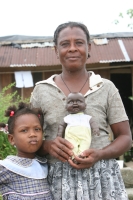Thursday, April 25, 2024
News and Views from the Global South
LATIN AMERICA: Black Population – Still Largely Invisible
- Making the contributions by black people to the cultural heritage of Latin America visible is one big step towards pulling people of African descent out of the poverty and marginalisation in which so many still live, said participants at a regional seminar in the Uruguayan capital.

Black local residents of village on Atrato River in northwest Colombia. Credit: Jesús Abad Colorado/IPS
Experts taking part in the seminar on “Afro-descendant Women and Latin American Culture: Identity and Development”, sponsored by the United Nations Development Programme (UNDP), stressed the need to raise awareness about the region’s black population and heritage.
“When you try to find data on the Afro-descendant population, it’s very hard to do. There are no statistics to help us find out what is going on, no specific indicators on infant or maternal mortality rates, or nutrition, among blacks,” UNDP regional director for Latin America and the Caribbean Rebeca Grynspan told IPS, describing the “invisibility” of this segment of the population in the region.
“The only approach available to us is to look at specific regions, because many people of African descent live in fairly identifiable areas. But that means we can only gauge the situation indirectly,” she said on the sidelines of the Sept. 27-29 seminar.
But the absence of broken down statistics is just one aspect, she stressed. “Blacks also suffer from invisibility with regard to their contribution to Latin American history and culture, and with respect to their movements, and their influence on what we do or what we sing.”
The seminar drew representatives from Argentina, Belize, Bolivia, Brazil, Chile, Colombia, Costa Rica, Ecuador, Guatemala, Honduras, Mexico, Nicaragua, Panama, Paraguay, Peru, Uruguay and Venezuela.
The UNDP is carrying out a series of projects to boost the visibility of the black population in the region, especially by highlighting their influence on Latin American culture and working to obtain more information on the situation of the rights of blacks.
“This is the first step, because if you don’t see something, you’re not worried about it, you don’t think about improving the situation, and you don’t believe there is any problem,” said Grynspan.
Despite the “statistical invisibility,” there is enough information to allow the UNDP to determine that there is a large gap between people of African descent in the region and other population groups in terms of living conditions and access to health care and education.
In Colombia, for example, the overall illiteracy rate stands at six percent, compared to 31 percent among blacks. And in Peru, the average number of school years among blacks is 6.3, while the national average is 7.3.
The extreme poverty rate is twice as high among blacks and indigenous people in the region as among the rest of the population, according to the U.N. agency.
In Uruguay, the average wage earned by black men is 70 percent of the average for the rest of the population.
In Brazil, blacks are hit harder by unemployment than other segments of the population, while joblessness among black women is more than twice as high as among black men.
Sixty percent of the black population in Colombia has no access to basic health care, and 51 percent has no health insurance, the UNDP reports.
The infant mortality rate in Latin America is between 40 and 50 percent higher among people of African descent than among the rest of the population.
Although she said the current global economic crisis has also hit that sector of the population especially hard, Grynspan stressed that “discrimination is not only a problem in material terms, but runs deeper than that…It is a problem of cultural discrimination, discrimination in terms of rights, and the institutions reproduce that discrimination, which undermines our ethical values of equity,” she said.
The participants agreed that culture should be used as an integrating mechanism.
In Uruguay, for instance, “the broad popularity of candombe (a drum-based musical genre with African roots), which is part of the identity of the entire population, is a model of a bridge between races, a symbol of unity and social integration, and thus a route for the black population to get ahead,” Uruguayan lawmaker Edgardo Ortuño, of the governing left-wing Broad Front coalition, told IPS.
“Culture is the big bridge that can bring about unity among human beings above and beyond ethnic and racial differences, and it has the potential to sensitise people and promote important values of integration,” added Ortuño, the first – and only – black legislator in this South American country.
For her part, Silvia García Savino, director of the UNDP’s project on people of African descent in Latin America, also stressed the importance of “cultural visibility.”
“We agree on the need to highlight the culture and folk wisdom of the Afro-descendant population…which are generally known through music and dance,” she said at the end of the seminar.
“We want citizens who fully enjoy their rights, and we believe that the recognition of cultural rights will have a positive impact on other rights. That is the route we should follow,” she added.
Barack Obama, as first black president of the United States, was also mentioned as an important symbol.
Obama’s election “is one of the most powerful symbolic events in recent times, as it sends the message that the entire black community can improve their conditions by making an effort,” said Ortuño. “At the same time, it is an important sign of the progress made by (U.S.) society as a whole, which has put human values above racial differences.
“Coming from a country with such a strong history of racism like the United States, a sign of hope and social integration has been spread throughout the world – one that we should pick up on and replicate throughout Latin America,” he said.

 Print
Print



